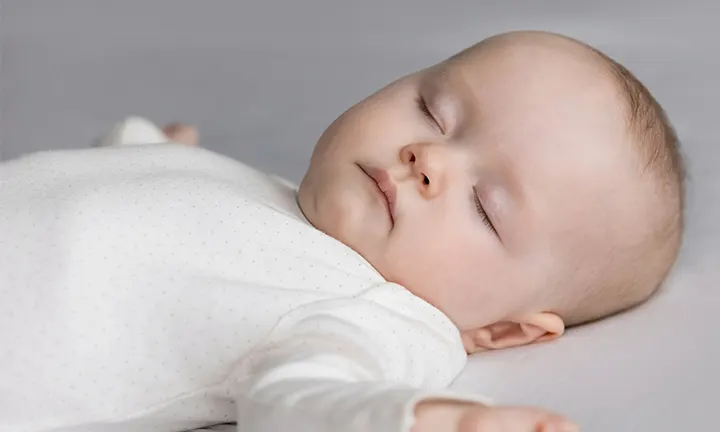What Is the Ideal Room Temperature for a Sleeping Baby?
Key Takeaways for Better Baby Sleep
One of the key ways to help your baby sleep better and longer is by maintaining a temperature of 68-72°F. Multiple studies, and our own experiences, show this is the ideal temperature for nurturing your baby’s sleep. It’s not too hot and not too cold – the Goldilocks number. Plus, as we explain below, maintaining this temperature helps reduce overheating and SIDS.
Additional information includes how to put your baby safely in the crib and why you should keep your baby in your room for at least the first six months. Also, to help keep your baby resting happily and healthily, follow these other guidelines: back to sleep, no toys, blankets, or pillows, and avoid overdressing your baby.
Baby sleep temperature is just one of many important factors in supporting a healthy sleep environment. For additional guidance on sleep, download the Smart Sleep Coach by Pampers™ app. It's packed with expert-led classes and tools to help get sleep on track. Best of all, the smart sleep schedule updates automatically with each sleep tracked to be in tune with your baby’s unique sleep rhythm.
Looking for help today? Take this FREE sleep assessment.
When your baby sleeps, so can you! That's just one of many reasons to aim for a comfortable environment that enables your little one to nod off more easily and stay asleep longer.
Good sleeping habits are crucial as your baby grows and develops, and supporting safe and healthy sleep comes down to a few basic strategies. One of them is making sure that your baby’s room is kept at an optimal temperature when it’s time for sleep.
So, how do you know what’s too high and what’s too low? Read on to learn what the best temperature is for your sleeping baby, how to get the room feeling just right, and how to help keep it that way.
Ideal Temperature for Your Baby’s Room
Did you know that temperature significantly impacts the quality of your baby’s sleep? Finding that sweet spot can seem difficult, but a general rule of thumb is to keep your baby’s room at a temperature that you find comfortable yourself.
When it comes to the ideal temperature for your baby’s room, regardless of winter or summer months, experts recommend maintaining a temperature within the range of 68 to 72 degrees Fahrenheit, or 20 to 22 degrees Celsius.
Why Setting the Ideal Temperature Is Important for Your Baby
When your baby’s room temperature is too high or too low, they may not sleep as long or as well. Keeping your baby’s room at the best temperature for sleep can help foster the quantity and quality of sleep necessary for healthy development.
Maintaining the right ambient temperature for your sleeping baby also helps prevent overheating. This, in turn, can help reduce the risk of sudden infant death syndrome (SIDS) and other serious health issues.
Keeping Your Baby Comfortable During Sleep
In addition to maintaining a comfortable room temperature, here are some other steps to help keep your baby safe and comfortable as they sleep:
| Signs Your Baby May Be Too Hot | Signs Your Baby May Be Too Cold |
|
|
Back to Sleep: Put your little one down to sleep on their back up until their first birthday. This is the safest sleep position for your baby, as it helps reduce the risk of SIDS. Daily tummy time is important but should only be done under your supervision and only when your baby is awake.
Keep the Crib Clear: Keep your baby’s crib free of everything except for the mattress and fitted sheet. Avoid blankets, loose sheets, pillows, bumpers, and stuffed toys, as they can lead to suffocation or choking.
Avoid Overdressing: Too much clothing can cause your little one to overheat and may restrict breathing.
Room Sharing: Place your baby’s crib in the same room as you for the first 6 to 12 months. This allows you to monitor their sleeping habits and be close by if they need you during the night.
Monitor Temperature: The best way to ensure your baby’s room temperature is just right is with a thermostat. Certain video monitors come with built-in thermostats to help you track temperature and humidity easily.
Signs Your Baby May Be Too Hot or Too Cold
If you’re worried that your baby appears to be hot or feverish, or is becoming overheated even when the room’s temperature is cool and comfortable, contact your baby’s healthcare provider right away for expert advice.
FAQS AT A GLANCE
Your baby’s room should feel comfortable to you but on the cool side, with good circulation. Make sure your baby's crib is not placed next to a radiator or a window.
Conclusion
Maintaining the ideal room temperature is crucial for your baby’s sleep quality and overall well-being. By keeping the room temperature between 68-72°F and following safe sleep practices, you can help ensure your baby sleeps soundly and safely.
How We Wrote This Article The information in this article is based on expert advice from trusted medical and government sources, such as the American Academy of Pediatrics and the American College of Obstetricians and Gynecologists. Always consult medical professionals for diagnosis and treatment.
Join a World of Support




